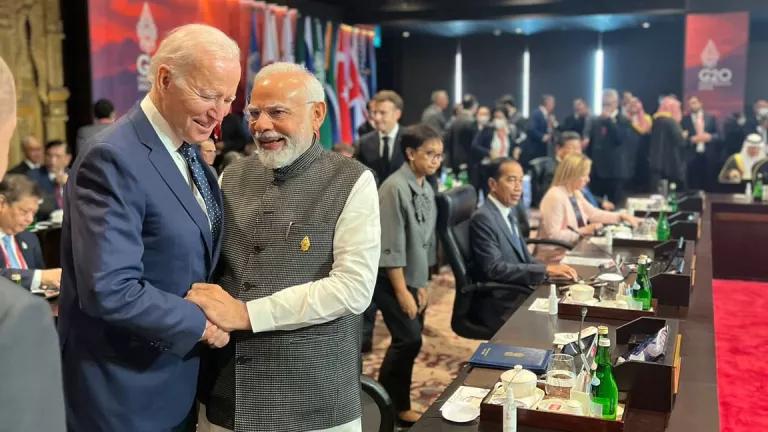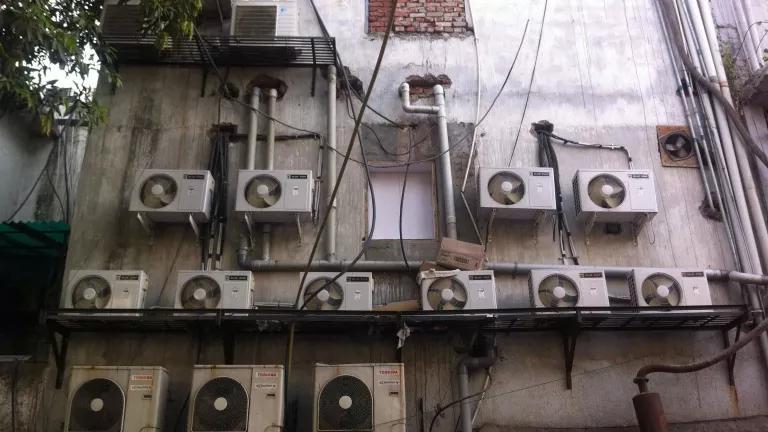US-India Climate Partnership: A World of Opportunities
Deepening the strategic partnership between the United States and India on issues of climate change and clean energy.

PM Modi meets President Biden at the 2022 G20 Bali summit
PMO India/Twitter
Prime Minister Narendra Modi’s Official State Visit to the United States this week, follows a series of high-profile meetings between him and President Joe Biden over the past year. The two leaders have affirmed the deep and close partnership between the U.S. and India, and among other bilateral issues, strategic collaboration on climate change and clean energy is expected to be high on the agenda.
Given the severity of the climate crisis and the increasingly irreversible changes to the climate system, the actions of the United States and India will have a profound impact on how we tackle climate change. In 2015, at the COP21 in Paris the world agreed to limit global warming to 1.5OC. This year, the COP28 in the United Arab Emirates marks the first “global stocktake” where countries will assess and track the progress towards achieving the goals of the Paris Agreement. India and the U.S., two of the world’s largest economies, require close cooperation to meet their ambitious national climate and clean energy goals, as well as to ensure that the world remains on track to combat global warming.
Here are three key climate priorities facing the two nations.
Decarbonizing economic growth through renewable energy development and deployment
The U.S. Inflation Reduction Act (IRA) will unleash a substantial level of investment creating major opportunities for the clean energy transition in the United States, but it also presents some risks to global collaboration as its climate policies could be perceived as trade protectionism:
- Access to advanced climate technology: The United States can, and should, make emerging climate and clean energy technologies spurred by domestic incentives widely available for other countries, especially hydrogen and other battery and energy storage technologies. Platforms such as the U.S.-India Hydrogen Task Force, and the U.S.-India Strategic Clean Energy Partnership could be leveraged to support the large-scale integration of renewable energy needed for the clean energy transition in India.
- Targeted end-use: The key to achieving a net-zero economy will be through exchange of technology and know-how around the most effective use of hydrogen for decarbonizing the industrial sector. There are opportunities for deeper industry and B2B collaboration in hard-to-abate industries such as steel, cement, and fertilizers.
- Carbon pricing: As India prepares for a domestic carbon market, there is an opportunity to meaningfully engage the private sector and industry in strategic discussions around decarbonization and setting globally acceptable methodologies for pricing carbon in key sectors.
- Critical minerals: Critical minerals and materials needed in clean energy technologies have emerged as a major strategic issue, as any supply disruptions has the potential to delay the pace of clean energy deployment. The U.S.-India Initiative on Critical and Emerging Technologies (iCET) is a good opportunity to strengthen their partnership in the clean energy transition and create a resilient supply chain for critical minerals.
Bringing global attention to climate friendly cooling in the face of extreme heat
Rising temperatures and rapid urbanization have spurred the need for cooling worldwide. By turning the focus on the cooling needs of people in heat stressed, developing parts of the world, India is keen to increase the profile of cooling efficiency in the face of extreme heat. The following issues for discussion could emerge from these two interrelated climate impacts:
- Swift technology transfer: Best available technologies and low global warming refrigerants for cooling equipment are either patent protected or not available to industry in developing countries. Making these available for global use and increased collaboration on life cycle refrigerant management for emissions avoidance would be beneficial for supporting implementation of the HFC phase down under the Kigali Amendment to the Montreal Protocol in India and other developing countries.
- Standards and labelling: The two countries can collaborate to develop globally acceptable, rigorous safety standards and life cycle management mechanisms to minimize refrigerant leakage, reclaim, and reuse. Similarly, for electrical appliances, sharing best practices on compliance and enforcement of energy efficiency standards and labels will be beneficial to decarbonization efforts in both the countries.
- Buildings and cool roofs: The scale of India’s urbanization offers a huge opportunity for the two nations to collaborate on green and net zero carbon building technologies. India has had success in traditional and passive cooling strategies such as cool roofs that would be useful for efforts to alleviate the rising heat stress in towns and cities in the United States.
- Encourage research and innovation: The United States could offer financial support to the Global Cooling Prize, which is a global competition designed to incentivize the development of a climate-friendly residential cooling solution.
Unlocking greater finance and investment for the clean energy transition
The United States must prioritize enhancing its public climate finance to achieve its $11.4 billion per year commitment by 2024. In addition, the U.S. could turn to the following issues to unleash greater public and private finance for climate and clean energy transitions in India and other developing countries:
- Prioritize Loss and Damage: Increase dialogue on defining and classifying loss and damage activities, and operationalizing the "Loss and Damage” Fund, in addition to the main sources of multilateral climate finance.
- Support multilateral climate action: The United States could commit financial support for the India-led multilateral efforts under the International Solar Alliance (ISA) and the Coalition for Disaster Resilient Infrastructure (CDRI), which could in turn unlock additional public and private finance into a range of activities focused on solar energy access and increasing climate resilience.
- Reform the international financial architecture: India has prioritized delivering a “Green Development Pact” as a pillar of its G20 presidency, which presents an opportunity for the United States to provide a political commitment to reform the international financial system for equitable and resilient development aligned with the Paris Agreement. The U.S. can leverage its influence to drive critical and meaningful reforms in international financial institutions (IFIs) and multilateral development banks (MDBs) with innovative financing tools to enable greater climate action.
PM Modi’s visit to Washington, D.C. will be marked by a state dinner, as well as an address to a Joint Meeting of the United States Congress. Even as the strategic partnership between the world’s oldest and largest democracies continues to grow, it will be important to track how President Biden and PM Modi choose to deepen their engagement on confronting the common challenge of climate change.





